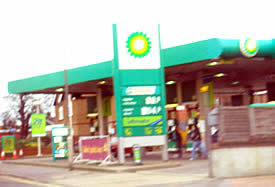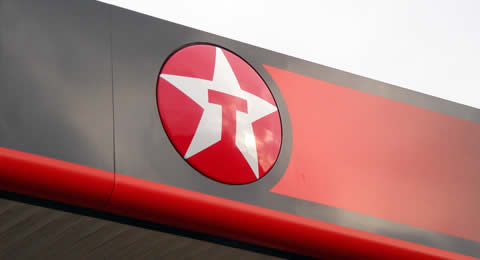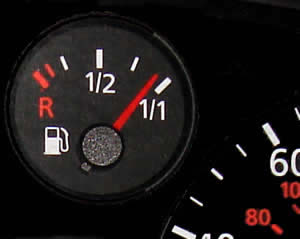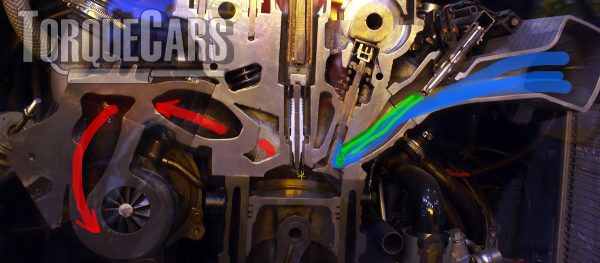Choice of fuel becomes more critical in a high compression or turbo engine.
"One of my Pet(rol) hates!"
 Fuel: this is regulated by a pressurize valve at the engine end – generally more fuel means more power but you also need more air as well – certainly an induction kit on larger engines and preferably a turbo or supercharger.
Fuel: this is regulated by a pressurize valve at the engine end – generally more fuel means more power but you also need more air as well – certainly an induction kit on larger engines and preferably a turbo or supercharger.
If the mixture is too rich a catalyst would be destroyed as unburned fuel enters the catalyst and burns inside it melting the catalytic structure so there is a delicate balance to maintain. This balance is referred to as the air to fuel ratio or even AFR. The combustion process involves the interaction of oxygen with fuel, and the stoichiometric point is defined as the point at which precisely all oxygen is consumed and all fuel is burnt.
Some of the oxygen remains unreacted when there is more than stoichiometric combustion. Similarly, if the combustion is partial owing to a lack of oxygen, the fuel stays unreacted.
(Unreacted fuel may also be present owing to sluggish combustion or inadequate mixing of fuel and oxygen - this is not related to stoichiometry.) Because various hydrocarbon fuels include varying amounts of carbon, hydrogen, and other components, their stoichiometry varies.
We'll discuss this later but in the mean time we'll look at the components that deliver the fuel to your engine.
Fuel regulator valves
High pressure fuel regulators should be fitted by a competent mechanic who can tune the engine to give the best fuel to air mix for your driving style and will keep the cat alive. A pressure reading will need to be taken before and after to give an indication of the optimal range of fuel pressure boost.
 An engine has to burn something.
An engine has to burn something.
This is typically petrol or diesel although many alternative fuels are springing up.
Additives can assist the combustion process and keep things efficient.
How diesel engines work
Diesel is detonated by pressure in the engine, rather than by a spark, and takes a little longer to burn than petrol. This is why diesel engines tend to have lower revs, although with Turbo charging and pre warmed fuel, Diesels are catching up petrol.
Due to the combustion method a diesel is going to be more efficient than a petrol engine. The 'magic ingredient' in Diesel is called Cetane and in Petrol we have Octane.
Reducing the risk of knock
High-octane fuel burns more efficiently and lower octane fuel can actually cause detonation or engine knock in high performance engines (where the pressure in the cylinder causes combustion prematurely.)
Japanese cars typically use 100 Ron fuel in their native country – the best we get in the UK is about 98RON (Shell Optimax, Bp Ultimate).
Bear in mind that in different regions the RON or Octane ratings are based on different measurements.
 I can usually tell if I have high octane fuel in my car after a few miles driving so recommend that you pick a fuel that suits your style of driving. There is also variation between brands as various additives are included so try different brands and stick with one that you prefer.
I can usually tell if I have high octane fuel in my car after a few miles driving so recommend that you pick a fuel that suits your style of driving. There is also variation between brands as various additives are included so try different brands and stick with one that you prefer.
Easy ways to check your car engines efficiency
Looking up the exhaust pipe makes you look like a weirdo, but gives an indication of what the inside of the engine is like. Black oily soot – bad, the engine is probably burning oil and running too rich adjust oil grade used and check the injectors/carb settings.
Grayish or white soot – very clean burning engine - although the mixture could be a little too lean (a long journey can really benefit an engine if you have a good fuel and will produce a grey soot in the exhaust.) Dark grey to black dusty soot – fairly normal and what most car owners should aim for.
Removing the spark plugs will also tell you a lot about the condition of the engine including weather the plugs are too cold/hot or there is an ignition problem and the plugs can look very different from cylinder to cylinder (so check them all) – consult a workshop manual for details of diagnosing an engines condition from the plugs.
Fuel Additives
Additives can help increase the octane of the fuel but I actually found my car became sooty when I used them – I assume that they have moved on now but I am still reluctant to use a fuel additive.
Some have started adding acetone to fuel, but acetone dissolves plastic so TorqueCars are not recommending this unless you know your cars plastic is resistant.
A good fuel will help to clean the injectors/carb and remove and prevent further carbon build up in the engine.
Many additives work by cleaning the injectors and valves. They often raise the burn temperature or use the temperature in a catalytic effect to burn off the residue of tars, gums and soot's that are inevitable when burning fuel. Other additives change the chemical mix of fuel and raise the octane. Many of these are gimmicks but in our forum we recommend the most useful ones.
Performance fuel injectors
Performance injectors operate by sending more fuel into the combustion chamber, significantly enhancing the power and performance of your vehicle (as long as it is paired with adequate air).
While it is true that more gasoline does not equal greater power, a tuned vehicle will often run lean as the fueling fails to keep up and you will lose power.
As a result, a performance injector tuned to supply more fuel will avoid this deficiency and recover your lost power.

How Fuel Injectors Operate
Gasoline injectors are in charge of supplying fuel to the engine.
This is accomplished by utilizing a fuel pressure regulator, which sucks gasoline from the tank via a fuel pump and readies a shot of fuel for the cylinders by maintaining a pressurized reserve of fuel in the fuel system.
Following that, the fuel injectors spray a thin mist of gasoline into the combustion chamber when required, usually via the ports but now directly into the cylinder is becoming common.
In previous vehicles back in the day, this was accomplished by the use of a carburetor system, which was inefficient and detrimental to the environment.
Fuel injection systems are classified into two types: mechanical and electronic.
Nowadays, most automobiles use an electronic fuel injection system. This is due to the ease with which electronic fuel injection systems may be programmed to meet the vehicle's exact fuel requirements.
Stock fuel injectors are capable of delivering the correct quantity of gasoline to a stock engine.
Stock fuel injectors, on the other hand, will reduce performance in engines equipped with an aftermarket turbo or supercharger since they won't be able to keep up.
Even if a turbocharger or supercharger allows more air into the combustion chamber, standard injectors will not be able to provide enough gasoline to the engine.
However, before you run out and buy a new set of performance fuel injectors, you should take some time to plan your purchase based on the changes to your vehicle.
Fuel Stoichiometric Ratios Gasolene fuel requires 14.7 parts air to 1 part fuel, with modest variations depending on engine conditions and workload.
Because of the unusual way diesel engines consume fuel, a diesel engine is lower at 14.5 parts air to 1 part diesel fuel, essentially running lean.
The stoichiometric point is reached when all oxygen and all fuel are used during the combustion process. Some of the oxygen is left unreacted with more oxygen (over stoichiometric combustion).
Similarly, if the combustion is incomplete due to a lack of oxygen, the fuel remains unreacted. (Unreacted fuel may also remain due to slow combustion or insufficient mixing of fuel and oxygen; this has nothing to do with stoichiometry, although a good injector design will increase fuel atomization and mixing.)
Because of variances in carbon, hydrogen, and other components, the stoichiometry of different hydrocarbon fuels varies and is carefully monitored and handled by your car's ECU.
Please Check out my YouTube channel, we're regularly adding new content...
PLEASE HELP: I NEED YOUR DONATIONS TO COVER THE COSTS OF RUNNING THIS SITE AND KEEP IT RUNNING. I do not charge you to access this website and it saves most TorqueCars readers $100's each year - but we are NON PROFIT and not even covering our costs. To keep us running PLEASE Donate here
If you liked this page please share it with your friends, drop a link to it in your favourite forum or use the bookmarking options to save it to your social media profile.
Feedback - What do You Think?
Please use our forums if you wish to ask a tuning question, and please note we do not sell parts or services, we are just an online magazine.
Help us improve, leave a suggestion or tip
Please watch this video and subscribe to my YouTube channel.
2 Responses to “Fuel and fuel additives octane and pressure boost valves.”

 Click to accept YouTube Cookies & Play.
Click to accept YouTube Cookies & Play.
I haven’t seen anything about an aftermarket throttle body. You’ll notice a big difference if you go from a 1 barrel 750 cfm stock tb to an aftermarket 4 barrel 1200 cfm.
I would like to know more about using bioethanol in high performance applications because it allows using more boost and Its much cheapear as well than petrol